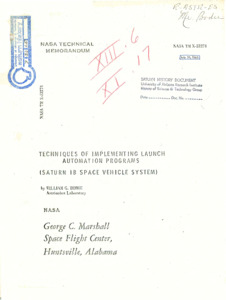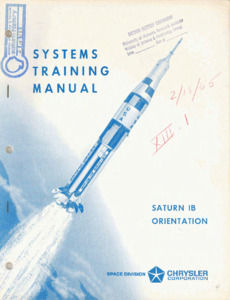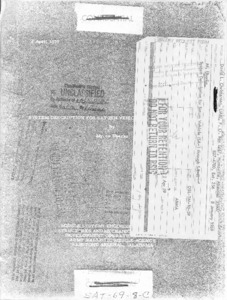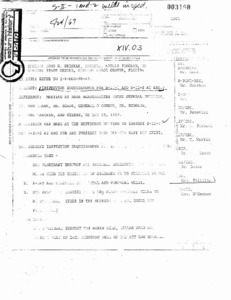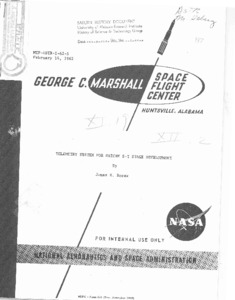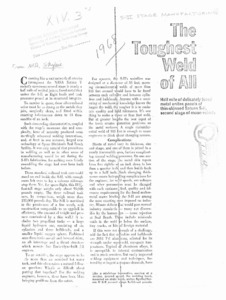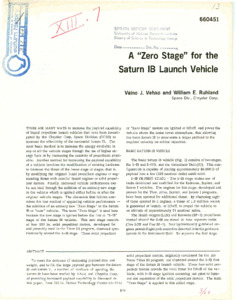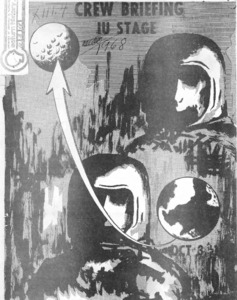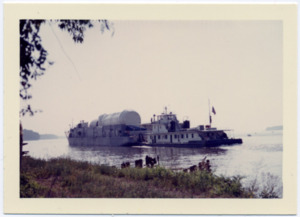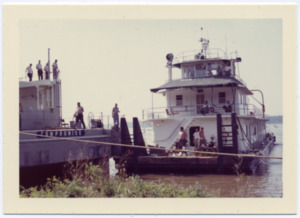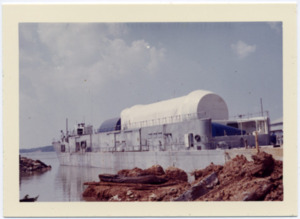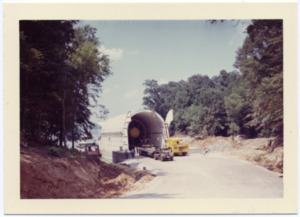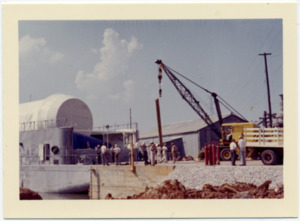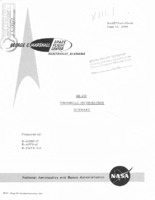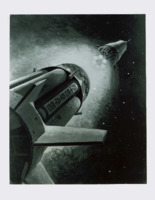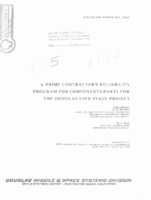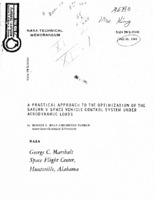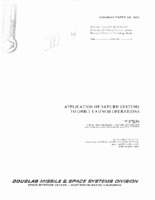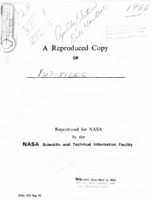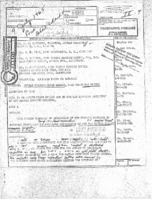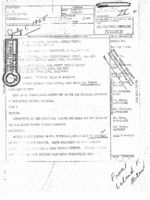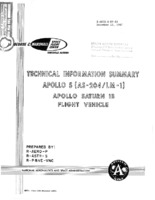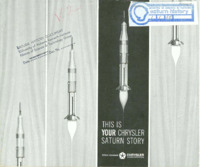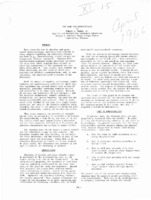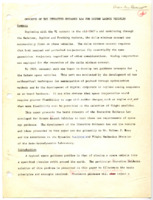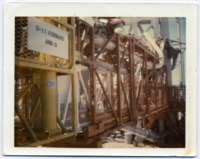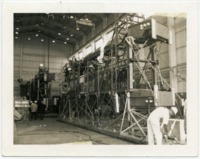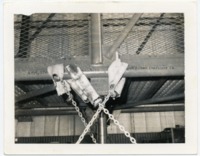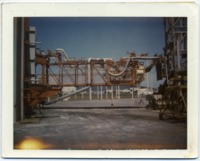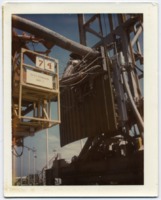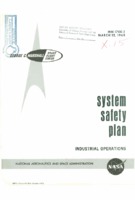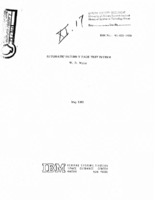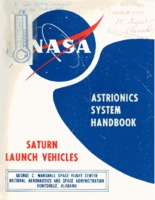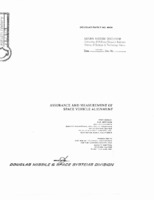
Browse Items (175 total)
Sort by:
-
"Techniques of implementing launch automation programs" (Saturn IB space vehicle system).
This paper identifies the methods and equipment through which automation is becoming a major factor in testing and launching Saturn IB space vehicles. The merits of a digital guidance computer and its impact in extending automated checkout are stressed; also a logical basis is established for computer and manual test control. Hardware and software elements of the automated system are described, and details pertaining to reliability are emphasized. A concluding appraisal suggests that automation will play an expanding role in future test and launch operations. -
"Saturn IB orientation training manuel."
Prepared through joint efforts of Personnel Department, Education and Development Branch, Systems Training Unit, Michoud Operations and Engineering Communications Department, Technical Information Branch, Applied Communications Engineering Section, Huntsville Operations.; This publication presents a brief descriptive summary of the Saturn IB vehicle and Chrysler's Corporation's accomplishments in the missiles and space field. The Saturn IB information presented herein is based on current plans for each of the stages. Although there may be design changes from vehicle to vehicle, the basic components, systems, and operating principles will remain similar to previous models. -
"System description for Saturn vehicle (SA-1 through SA-4)."
Missing pages iv, 3, 6 to 8. Photocopy of files containing sections of the project. -
"Telegraphic message : inspection requirements for S-II-1 and S-II-2 at KSC."
Photocopy of an inspection list requirements for S-II-1 and S-II-2. -
"Telemetry system for Saturn S-I stage development."
The telemetry system used on the Saturn S-I stage for the transmission of vehicle test data is described. Multiplex and modulationtechniques such as PAM/FM/FM, SS/FM and PGM are used in the system. The diverse data requirements for developing the eight-engineliquid-fueled stage necessitated the use of a combination of severalmodulation techniques to efficiently handle the data. A cursory comparisonis made of the merits of each technique. Physical and electricalrequirements and characteristics of the system are outlined. -
"The toughest weld of all" S-II stage manufacturing.
Article explores the outer layer of the Saturn S-II along side its benefits and complications. Contains poorly rendered images displaying the process. -
"A 'Zero Stage' for the Saturn IB Launch Vehicle."
To meet the demands of increasing payload size and weight, and to fill the large payload gap between the Saturn IB and Saturn V, a number of methods of uprating the Saturn IB have been studied by NASA and Chrysler Corp. of providing increased payload capability is discussed in this paper. Four 120 in. United Technology Center UA-1205 solid propellant motors, originally developed for the Air Force Titan III program, are clustered around the S-IB first stage of the Saturn IB launch vehicle. These four solid propellant motors provide the total thrust for liftoff of the vehicle, with S-IB stage ignition occurring just prior to burn-out and separation of the solid propellant motors. The term "Zero Stage" is applied to this added stage. -
"Vibration and acoustic environment characteristics of the Saturn V launch vehicle."
This paper presents representative examples of vibration and acoustic data from flights of the Saturn V launch vehicle and static firings of Saturn V launch vehicle stages. The purpose of the paper is to provide vibration and acoustic environment characteristics which are pertinent to the design of launch vehicles -
"Crew Briefing : Instrument Unit Stage Presentation".
Document outlining different slides of a presentation containing numerous organizational charts, diagrams and bullet-list points. -
A Saturn rocket stage is loaded onto a barge on the Tennessee River.
The stage is being transported to the Mississippi Test Facility. -
A Saturn rocket stage is loaded onto a barge on the Tennessee River.
The stage is being transported to the Mississippi Test Facility. -
A Saturn rocket stage is loaded onto a barge on the Tennessee River.
The stage is being transported to the Mississippi Test Facility. -
A Saturn rocket stage is loaded onto a barge on the Tennessee River.
The stage is being transported to the Mississippi Test Facility. -
A Saturn rocket stage is loaded onto a barge on the Tennessee River.
The stage is being transported to the Mississippi Test Facility. -
"AS-203 Technical Information Summary."
"This report outlines, through a series of sketches with accompanying text, the general features of the SA-203 Launch Vehicle and information on launch preparation, the launch facility and mission peculiar experiments." -
Artist's Conception of the RL10-powered Saturn S-IV Stage.
This artist's rendering of the RL10-powered Saturn S-IV stage is depicted as heading toward deep space after separation from the booster. The drawing is accompanied with a brief description of the Saturn S-IV. -
"A Prime Contractor's Reliability Program for Components/Parts for the Douglas S-IVB Stage Project."
This paper, presented at the fifth annual Reliability and Maintainability Conference in New York City, contains a "prime contractor's reliability program for components/parts for the Douglas S-IVB stage project." These parts include special flight critical items and their complementary reliability engineering program plan is outlined in this paper. -
"A Practical Approach to the Optimization of the Saturn V Space Vehicle Control System Under Aerodynamic Loads."
This paper includes the equations for the bending moment of a launch vehicle with the effects of bending and sloshing dynamics. It also includes a comparison between the bending moment response envelope of the measure winds and the bending moment response of the MSFC synthetic wind profile. -
"Approach in Achieving High Reliability for Saturn Class Vehicles."
This paper focuses on an approach for achieving high reliability within the Navigation, Guidance, and Control systems of the Saturn class launch vehicles. -
"Application of Saturn Systems to Orbit Launch Operations."
Presented at the AIAA/AAS Stepping Stones to Mars Meeting, this paper compares the "payload velocity spectrum for existing and future missions" with Saturn V capabilities. -
The "Apollo/Saturn Data Handbook."
According to the preface, "This handbook provides KSC management personnel with general information relative to the Apollo-Saturn program. Emphasis is placed on Saturn launch facilities and related support equipment. Saturn vehicle parameters are included for general information. -
Telegraphic message containing an Apollo Program Flash Report.
This message for the Apollo Program Director contains a report of the Apollo launch vehicles, problem that occurred, and actions required. The photocopy is difficult to read. -
Telegraphic message containing an Apollo Program Flash Report.
This message for the Apollo Program Director contains a report of the Apollo launch vehicles, problem that occurred, and actions required. The photocopy is difficult to read. -
Technical information summary of the Apollo Saturn 1B flight vehicle.
According to the summary found on page 1, this document "presents a brief and concise description of the AS-204/LM-1 Apollo Saturn Space Vehicle." The information within the document allows readers to follow the timeline of the space vehicle's lift-off and journey to space. -
"Apollo 4 Pre-Launch Press Conference."
This document contains a transcription of the pre-launch press conference for Apollo 4. It includes the questions asked and answers given by participants Dr. Robert C. Seamans, Dr. George E. Mueller, Major General Samuel C. Phillips, Dr. Kurt H. Debus, and Dr. Wernher von Braun. -
"This is Your Chrysler Saturn Story."
The document is a booklet created as part of the NASA/Chrysler Corporation Space Division manned flight awareness program. It discusses Chrysler's role in manufacturing and testing the Saturn and includes photographs and diagrams of Saturn stages, operations at Michoud, testing, and future missions. The section headings included in this booklet are "Chrysler and the Saturn," "Saturn at Michoud," "The Voyage of Saturn," "Saturn Firings," and "Saturn's Missions." -
"The Case for Compatibility."
"The Case for Compatibility" is a paper by Robert L. Smith, Jr., who worked in Quality and Reliability Assurance Laboratory at George C. Marshall Space Flight Center. The summary states, "Ever since the use of missiles and space launch vehicles began, questions have existed in every program regarding the similarity between upstream (e.g., manufacturing, static firing ) and launch site checkout equipment. Programs have existed which utilized nearly identical equipment for both uses; other programs have existed in which any resemblance of the equipment was probably coincidental. Many factors have entered the final decisions, not the least of which were economic and schedule considerations, and, in some instances, the organizational structure of the developer." -
Draft of "Concepts of the Iterative Guidance Law for Saturn Launch Vehicles."
The summary notes, "In 1960, research work was begun to develop new guidance concepts for the Saturn space vehicles. [...] This paper presents the basics of the Iterative Guidance Law developed for Saturn launch vehicles to meet these new requirements of space age guidance. The development of the Iterative Guidance Law and the results and ideas presented in this paper are due primarily to Mr. Helmut J. Horn and his associates in the Dynamics Analysis and Flight Mechanics Division of the Aero-Astrodynamics Laboratory." Marked "Research Review, OK" in the upper right corner of the first page. The document includes corrections and additions to the text in red pencil. -
Apollo 5 press kit.
For release Thursday P.M., January 11, 1968. -
"Automatic Saturn V Page Test System."
The abstract notes, "This paper describes the Automatic Saturn V Page Test System. The system is used to evaluate microminiature Unit Logic Device (ULD) circuits. A page is an assembly consisting of a magnesium- lithium frame, an input-output connector, test points, and multilateral printed circuit boards that interconnect the IUDs into logic circuits. The test system automatically performs tests for shorted voltages and shorted diodes, static logic function, and pulse function." -
Saturn Launch Vehicles Astrionics System Handbook.
Includes change pages. Contract NAS8-14000. Second revised edition. V66-15610. NASA-CR71607. The introduction notes, "This second revised edition of the Astrionics System Handbook has been developed under the direction and overall supervision of Dr. Rudolf Decher of the Astrionics Systems Engineering Office. This description of the Saturn Astrionics System has been generated by personnel of the Astrionics Laboratory, the staff of the Astrionics Systems Engineering Office, and by personnel of the International Business Machines Corporation working under Contract NAS8- 14000. The handbook will be updated and expanded as it becomes necessary due to changes or refinements in the system concept and hardware. Sections not contained in the first release of this document will be made available within three months." Signed by Ludie G. Richard, Chief, Systems Engineering Office, Astrionics Laboratory. The document is missing pages in the following locations: Chapters 8, 9, 12. Sections 15.2, 15.3, 15.4-1 thru 15.4-16, 15.5-1 thru 15.5-2, 15.5-5 thru 15.5-8. -
Saturn Launch Vehicles Astrionics System Handbook, 2nd revised edition.
This updated edition of the Astrionics System Handbook instructs, "The enclosed pages change, delete, or supplement the information in the Astrionics System Handbook (1 August 1965). Insert these pages and destroy the pages they replace." -
"Assurance and Measurement of Space Vehicle Alignment."
Prepared by A. W. Dryden, Quality Engineer, Quality Engineering, Reliability Assurance, Space Systems Center, Douglas Aircraft Company, Inc., Huntington Beach, California. Presented to the 21st Annual Technical Conference for the American Society for Quality Control, Chicago, Illinois. 30 May to 2 June 1967. -
"Apollo 6 Pre-Launch Press Conference."
The press conference was given at Cape Royal News Center in Cocoa Beach, Florida, on Wednesday, April 3, 1968, at 3:30 PM. Participants: William C. Schneider, Apollo Mission Director, NASA; George M. Low, Apollo Spacecraft Manager, NASA; Clifford Charlesworth, Apollo 6 Flight Director, Manned Spacecraft Center, NASA; Dr. Arthur Rudolph, Saturn V Program Office, Marshall Space Flight Center, NASA; Rocco A. Petrone, Apollo 6 Launch Director, Kennedy Space Center, NASA; Col. Royce Olson, USAF, Director DOD Manned Spaceflight Support Office, Patrick AFB; Chris Kraft, Director of Flight Operations, Manned Spacecraft Center.
